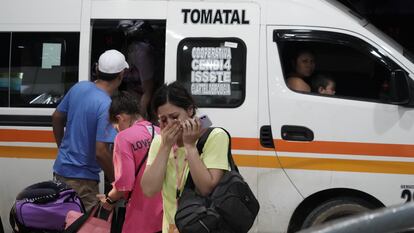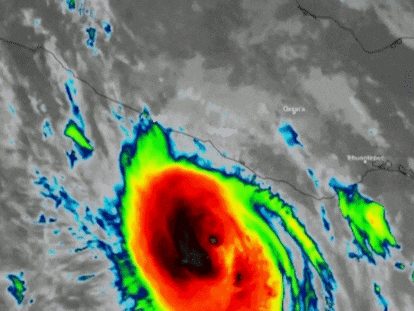Exodus from Acapulco after Hurricane Otis: ‘It was like living through a two-hour earthquake’
Tourists are fleeing the devastated city, which has been cut off since early Wednesday by the cyclone after it made landfall on the coast of Guerrero


Marisol Rodríguez and Maximiliano Cortés crossed Acapulco on Thursday with their baby, Lía, in their arms. They had walked more than seven kilometers to a bus station to flee a devastated city. Like them, there are thousands of people in what was until two days ago one of the tourist jewels of Mexico. On Tuesday, a mining convention began with more than 5,000 attendees, as well as a sporting event involving 800 children. Life was normal until Otis approached the coast, upgraded in just a few hours from a tropical storm to a category five hurricane. The federal government has so far confirmed 27 dead and four people missing, but large areas remain cut off without aid or assistance. Since early Wednesday morning, a state of emergency has engulfed Acapulco.
Reaching Chilpancingo, the capital of the State of Guerrero and about 130 kilometers (80 miles) from the center of the crisis, for tourists means electricity, internet connection, drinking water, and food stores. “You can’t buy anything in Acapulco, not even if you want to,” says Cortés. He and his family had barely been in the coastal city for a couple of days when the ninth floor of the Emporio Hotel began to sway. Then the winds, which exceeded 270 kilometers per hour (168 mph), blew out the windows of their room. They threw a mattress against a wall to protect themselves and when the gales died down, they sought refuge in the bathroom. From there they were pulled out by maintenance staff, who were gathering all the guests in a convention hall that was also flooded.
The horror story does not differ much among the buildings on the Miguel Alemán coastline, one of the central points of a city that has been thriving on tourism for decades. In the Playa Suites Hotel were the 800 minors participating in the state, sports, and cultural meeting of Guerrero. Luis Hernández and Alejandro Márquez were in charge of recording the event; instead, they have drone images of a city where 80% of the hotels have been affected. “It was like living through a two-hour earthquake,” say the young men, who are from Mexico City. “You see everything breaking into pieces around you, the girls were screaming. The wind looks for an exit point and blows everything through the corridors, sending it flying out.”

The images from Acapulco show a beach paradise turned into a shell. But the danger has not passed: the city has been without electricity since early Wednesday morning, which has caused cuts to the supply of drinking water. There is no telephone or internet connection, and food supplies have already begun to run low. Large chain stores such as Oxxo, Walmart, and Soriana have been looted. “The hotel told us that they could no longer guarantee water, food, or security,” says the Chávez family, who were gathering in Acapulco from their homes in Guadalajara, Ciudad Juárez and Tucson (Arizona).
Now the family reunion is being held in the Chilpancingo National Airport terminal with their suitcases scattered around as they try to find a way to continue their journey home. Their hotel, the Mayan Palace, made it easy for all their guests to leave Acapulco in the face of the alarming scenario looming over the city. They were among the last in the building, but not in Acapulco. The governor of the State of Guerrero, Evelyn Salgado, has said that 30 buses per day will be provided to evacuate tourists.
Pily and Juan, who arrived in Acapulco a few hours before the hurricane, have taken longer to leave than the mining convention they were attending. The stone walls of their hotel, Las Brisas, withstood Otis’ onslaught better than others. But they were already running out of food. They left Thursday at 10 a.m. in their rental car, asking the National Guard for directions, because there are no signs standing and Google Maps cannot be accessed. It took them seven hours to travel the relatively short distance to Chilpancingo.
“There are too many people trying to get out,” says the Chávez family, who describe the downed light poles, fallen trees, cars fleeing with broken windows and broken down vehicles on the road with no one to remove those that have become stranded. Vehicles leaving Acapulco are full. Cab drivers say that they are charging 500 pesos per passenger, about $25, for the journey. The tourists are fleeing without anyone in Acapulco knowing when they will return.

Sign up for our weekly newsletter to get more English-language news coverage from EL PAÍS USA Edition
Tu suscripción se está usando en otro dispositivo
¿Quieres añadir otro usuario a tu suscripción?
Si continúas leyendo en este dispositivo, no se podrá leer en el otro.
FlechaTu suscripción se está usando en otro dispositivo y solo puedes acceder a EL PAÍS desde un dispositivo a la vez.
Si quieres compartir tu cuenta, cambia tu suscripción a la modalidad Premium, así podrás añadir otro usuario. Cada uno accederá con su propia cuenta de email, lo que os permitirá personalizar vuestra experiencia en EL PAÍS.
¿Tienes una suscripción de empresa? Accede aquí para contratar más cuentas.
En el caso de no saber quién está usando tu cuenta, te recomendamos cambiar tu contraseña aquí.
Si decides continuar compartiendo tu cuenta, este mensaje se mostrará en tu dispositivo y en el de la otra persona que está usando tu cuenta de forma indefinida, afectando a tu experiencia de lectura. Puedes consultar aquí los términos y condiciones de la suscripción digital.
More information
Archived In
Últimas noticias
Most viewed
- Reinhard Genzel, Nobel laureate in physics: ‘One-minute videos will never give you the truth’
- Oona Chaplin: ‘I told James Cameron that I was living in a treehouse and starting a permaculture project with a friend’
- Pablo Escobar’s hippos: A serious environmental problem, 40 years on
- Chevy Chase, the beloved comedian who was a monster off camera: ‘Not everyone hated him, just the people who’ve worked with him’
- Why we lost the habit of sleeping in two segments and how that changed our sense of time










































